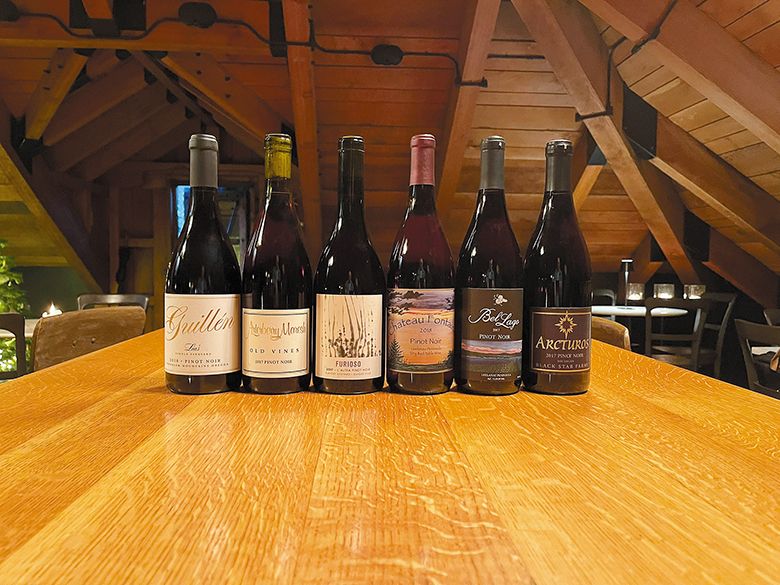Smitten with the Mitten
Blind tasting reveals surprising results for tasting panel


By Neal D. Hulkower
A Pinot Noir from Northern Michigan’s Leelanau Peninsula edged out three from the Willamette Valley and two others from the Wolverine State during a recent blind tasting. In addition, the De Ponte Cellars’ 2011 Lonesome Rock Ranch Pinot Noir was nearly unanimously preferred to Virginia’s Ankida Ridge Vineyards 2011 Pinot Noir. Before divulging the details, first, the backstory.
Paw Paw, in southwest Michigan, was my first stop on a road trip during the summer of 1976 (before my last year of graduate school). Then, as now, the village was known for its vineyards growing both table and wine grapes. The climate was not conducive for vinifera, so hybrids and labrusca, the species of the concord grape, proliferated. Most unpleasant was a Baco Noir, a cross between Vitis vinifera and Vitis riparia, made from vines planted where corn once grew. Something must have remained in the soil because the wine had obvious overtones of the previous crop. This encounter with Michigan’s weirdoir made me avoid other wines from there.
Since then, I have heard good things about vinifera wines being grown outside Traverse City, a much cooler area, and home to two of Michigan’s five American Viticultural Areas: Leelanau Peninsula and Old Mission Peninsula. A chance to taste in situ arose in August 2020 when our older son married Miss Wright, a Michigan native.
I supplied wine to the few drinking-age wedding guests for six days. While I brought a magnum of grower champagne and some Oregon Pinot Noir, I was eager to see if what I had read about Michigan Riesling and Pinot Noir was true. In the Old Mission Peninsula, we tasted at Chateau Grand Traverse and Black Star Farms. We also stopped at Chateau Fontaine and Bel Lago in the Leelanau Peninsula. Not as intense as Oregon Pinots, the wines were attractive with expected varietal characteristics.
I returned home with three Michigan Pinot Noirs: Bel Lago 2017, Black Star Farms 2017 Arcturos and Chateau Fontaine 2018, along with a few other varieties.
In December, these were evaluated alongside three Oregon Pinots: Arterberry Maresh 2017 Old Vine Pinot Noir, Furioso 2017 L’Altra Furioso Vineyard Pinot Noir and Guillén Family 2018 Lia’s Vineyard Pinot Noir.
The Tasting
The panel members were Courtney Cunningham, proprietress of Glint Creative which supports the Oregon wine industry; Dagoberto Guillén, guest ambassador at White Rose Estate; Anna Matzinger, winemaker/partner at the Matzinger Davies Wine Company; Madeline Pasquarelli, winemaker at Bergström Wines; Michael Pasquarelli, assistant winemaker at White Rose Estate; and me. We met in the White Rose tasting room to blind taste the six wines. Each judge made notes, ranking the wines without discussion.
I aggregated each wine’s tally using the Borda score to arrive at the consensus ranking.
We were surprised when the Bel Lago 2017 Pinot Noir edged out the Guillén Family 2018 Lia’s Vineyard Pinot Noir by 1.5 points. The two other Oregon Pinots lagged more than 10 behind the Guillén, while the two remaining Michigan Pinots, with Borda scores a mere 1 apart, represented the bottom two spots.
The judges observed that while each showed well, the Oregon wines were more complex and richer.
Ankida Ridge vs De Ponte Lonesome Rock Range, Round Two
The first vintage of Virginia’s Ankida Ridge and Oregon’s De Ponte Lonesome Rock Ranch Pinot Noirs was 2010. After sampling them, Oregon Wine Press published the results in my story, “Vindicating Thomas,” in the December 2012 issue. While the Ankida Ridge displayed varietal typicity, the Lonesome Rock Ranch was favored by the four sampling them.
I visited Ankida Ridge again in January 2013, following the wedding of our Virginia-based daughter, and tasted the 2010 next to the 2011 vintage. The younger vintage displayed none of the jamminess from the previous year. I learned all the fruit in 2011 was grown in the estate vineyard, whereas the 2010 was augmented with grapes picked at 25 brix from the lower elevation and hotter Stinson Vineyards. I was given a bottle of the 2011– the one recently tasted.
Yet again, the Lonesome Rock Ranch from the same year was preferred, this time by five of the six judges. Nevertheless, the Ankida Ridge showed very well, especially given its age. The winery has gone on to critical acclaim and was invited to pour at the 2016 IPNC.
Now What?
In contrast to my first encounter with Michigan wines almost half a century ago, I enjoyed those from vinifera grapes, including Pinot Noir and other varieties. While overall lighter and less complex than Oregon’s, their Pinots are pleasant, food-friendly examples. Prices are still reasonable as well. This blind tasting should encourage Michiganders and keep Oregonians on their toes.
Heck, should the occasion arise, I may even give Paw Paw a second chance.
Neal D. Hulkower is an applied mathematician and freelance writer living in McMinnville. His first contributions to a wine publication appeared in the early 1970s. Since 2009, he has been writing regularly about wine-related topics for academic, trade and popular publications including Journal of Wine Research, Journal of Wine Economics, American Wine Society Wine Journal, Oregon Wine Press, Practical Winery & Vineyard, Wine Press Northwest, Slow Wine Guide USA and The World of Fine Wine as well as wine-searcher.com, trinkmag.com, and guildsomm.com. Neal is a member of the Circle of Wine Writers. His first book, Grape Explications, will be released in 2025.










